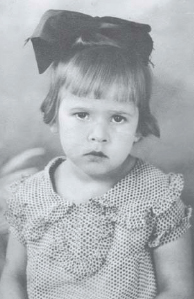
Why did I describe myself as a “combatant”? That word summed up our commitment to changing the status quo. We had complete confidence and faith in Fidel and were willing to fight in order to end once and for all the shame and moral degradation that Cubans had suffered.
There was no doubt or fear in my mind when, one day not long afterwards, on Faustino’s instructions, I approached the pharmacy on the San Pedro bridge. I was going to see Santiago Riera, who was the coordinator of the movement in the province at that time, to tell him I had joined. This was before the arrival of the Granma on December 2, 1956, bringing Fidel back from exile in Mexico, along with his intrepid followers.1
Although there wasn’t much information about how or when the guerrilla expedition would arrive, the leaders of the July 26 Movement in the province took some measures to support the action, while Santiago Riera returned to Santiago de Cuba to meet with Frank País to find out what was happening. Our group of women, led by Margot Machado, prepared to help by providing first aid to the combatants if there was a clash or wherever else we were needed for other tasks.
Aleida at the age of five, the only photo of her as a child.
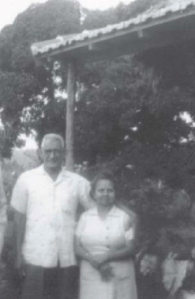
Aleida’s parents, Juan March and Eudoxia de la Torre, in front of their house in the country.
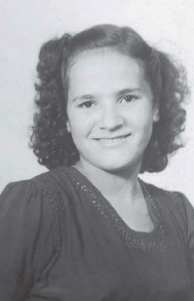
Aleida as a teenager.
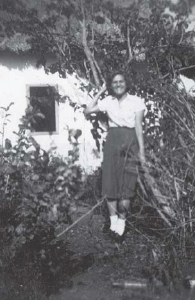
At her parents’ house in the country.
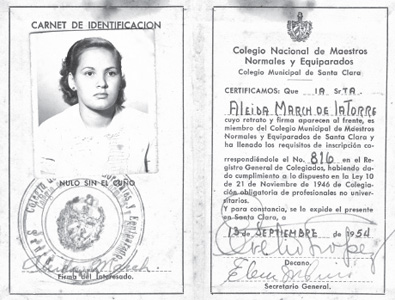
Aleida’s student cards from teacher training college.
Aleida playing softball at high school, 1948.
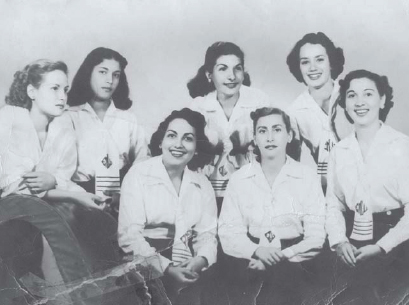
Aleida (left) with classmates at teacher training college, 1953.
On graduating from teacher training college, in 1953.Aleida (front row, second from the right)was elected Queen of the santa Clara Carnivals.

Graduation ceremony, 1953.
Central University of Las Villas (1955), where Aleida furthered her pedagogical studies (back row, second from the left).
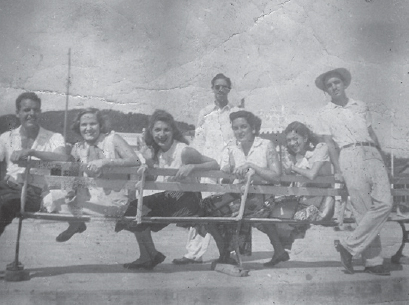
At her friend Mercedes López’s home in Rancho Veloz.
Santa Clara aqueduct.
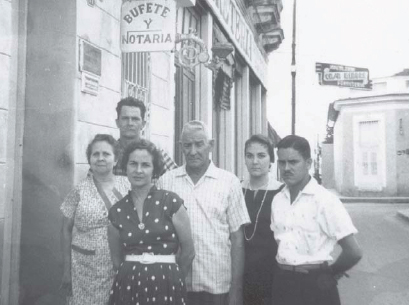
Aleida with her parents and siblings in Santa Clara.
Cabaiguán, after the town of Fomento was captured during the revolutionary war in 1958.

Cabaiguán during the campaign in Las Villas (1958).
Che Aleida on the way to Caibarien during the campaign in Las Villas (1958).
Che and Camilo Cienfuegos during the capture of El Pedrero.
Aleida and Teresita Orizondo at the command headquarters during the battle of Santa Clara (1958).
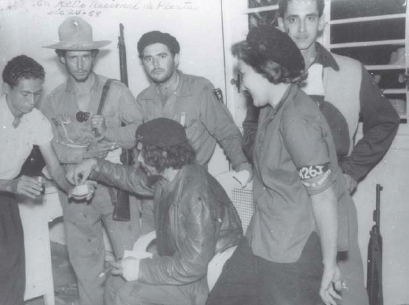
Aleida with Che at the National Radio station in Placetas.
Che, after troops from his Column 8 blew up Falcon Bridge.
In the barracks during the capture of Remedios.
Above Buena Nueva shop in a break during the battle of Santa Clara (1958).
In front of the armored train that was derailed in Santa Clara on December 29, 1958. (Photo taken by Che.)
Entering the city of Santa Clara in December 1958. “A very young Chinese photographer appeared, camera in hand. Thanks to him, this moment was preserved for posterity.”
The surrender of the Leoncio Vidal Regiment’s barracks.
We waited anxiously. We heard the initial reports about the events in Santiago de Cuba. On November 30,2 in that town on the east coast of the island, young people led by Frank País initiated actions to support the arrival of the Granma and to distract the troops of the Batista dictatorship. Our leading compañeros, Santiago Riera and Guillermo Rodríguez, who had been a part of the National Revolutionary Movement along with Armando Hart and Professor Rafael García Bárcena, arrived to coordinate the actions of our group in Santa Clara. But they only got as far as Camagüey and had to return. We could not contact them and didn’t know what to do. In the end nothing happened in Santa Clara. There were no precise instructions for how we could support the landing of the Granma, even though Haydee Leal had received instructions from Mexico. The movement had a national structure, but was far from being cohesive. We lacked—and here I include myself—the necessary political education and experience to meet the challenges required by the struggle.
In those early days, Haydee Leal’s house was the central meeting place for compañeros of the July 26 Movement leadership in our province. We had the support of her mother, Luisa Díaz. It is important to emphasize it wasn’t only young people willing to lend their support to the struggle, but also many mothers, who understood that they, too, had to take a stand and join the movement.
Then we heard alarming news reports about what had happened on December 2 when the Granma landed. We were keenly aware of the lies spread on the radio and in the press on behalf of the regime. But because we lacked any real information, we were upset by reports that Fidel had apparently been killed. We were distraught with frustration and bitterness until Faustino came to Santa Clara on one of his short visits, and he confirmed the leader of our movement was alive, fighting in the mountains. He described the landing of the Granma at Las Coloradas beach and the clash that had taken place at Alegría de Pío, resulting in the dispersal of the guerrillas.3
I didn’t know that I, too, would soon experience my own baptism of fire. I still remember the trepidation I felt when asked to go and meet someone at the home of (Lolita) Dolores Rosell, a friend and fellow combatant. To my surprise, Gino Done, an expeditionary from the Granma, who had managed to escape the enemy, had come to Santa Clara to participate in sabotage actions—at least that was what I was told. Gino, an Italian who had fought in the Second World War, was a sailor who had made many trips to Cuba. He had worked as a builder in Havana and elsewhere in Cuba, so he had easily found his way to Santa Clara. The mission Gino had come to complete before January 15, 1957, with me as his accomplice was—believe it or not—to throw a grenade at a Christmas tree that decorated the lobby of the building of the provincial government. The objective of this action was to draw attention to the fact that the insurrection had extended to the center of the island.
Small groups had already been formed to carry out courageous actions and sabotage. One of their first aims was to cut the power lines in order to support the grenade attack on the government building, located in the center of Santa Clara. When I think now about how we prepared for this action, I’m embarrassed, although at the time I felt proud that I had been chosen to carry out such a risky mission. I had to go by Lolita’s house that afternoon to pick up the grenade and carry it in one of her handbags. While I waited, I went back home and placed the handbag on top of my wardrobe. I had no idea how to use a grenade and I was totally irresponsible by putting my family at risk, given that anything could have happened.
It was a popular pastime to take a stroll in Vidal Park in the center of town, so nobody at home objected to my going there. I met up again with Gino and, armed with the grenade in the handbag I carried under my arm, we headed toward the government building at the precise time the electricity would be cut off. Just as we were about to execute “the plan,” the lights came back on and we had to leave without being able to do anything. All we could do was go back to Lolita’s house, return the grenade and go home feeling sad and frustrated. Without overstating it, this was my little Alegría de Pío.
On December 5, 1956, at Alegría de Pío, in the former province of Oriente, Fidel and the other expeditionaries from the Granma (including Che, who had joined as the troop’s doctor) were caught by surprise by Batista’s troops. This episode is vividly narrated by Che in his book Reminiscences of the Cuban Revolutionary War. He describes how, after walking for long hours through saltwater swamps, suffering many calamities, the survivors of the Granma expedition were completely exhausted. Many of them had lost part of their equipment when they found themselves in an unequal fight in which Che himself was injured. This was the first armed clash for what would become the Rebel Army, and Che described it as their “baptism of fire,” even though it did not end in victory.4
We were not entirely aware the tasks we were given would often endanger the lives of our families. Now I look back and recall the number of times I had to lie in order to leave the house. My parents didn’t understand and they certainly couldn’t accept that a young woman would put herself and her reputation at risk, especially in the early days when they were not quite sure what I was doing. Sometimes compañeros would risk coming to my house to leave urgent messages for me. My little niece Miriam was always curious when she learned about such visits. Even when my mother told her not to say anything, she would come to me quietly and whisper, “They came to see you.”
I would always leave the house with the excuse I was going to study at my friends’ home (the González family) or that I was going to work. At the time, my parents never imagined the dangers we faced, or how my activities endangered them also. Batista’s repressive forces had no scruples in applying the cruelest forms of torture. Unfortunately we Cubans were among the first to experience some of bloody practices that in later years became widespread throughout Latin America. It is therefore understandable that, when my parents found out what I was doing, they forbade my outings. Although I was young, I was old enough to make my own decisions. I didn’t want to hurt anyone and was always clear about my role and what I would and wouldn’t do. I know that my parents supported me as best they could, especially towards the end. In fact, my mother accompanied me on more than one occasion, when it was late or when she suspected there might be real danger. As time went by they became more reconciled to my activities and I didn’t have to explain myself quite so much, which meant I didn’t have to lie. Then one day I didn’t return home...
We were always trying to perfect what we did. I had to carry out numerous assignments. There were only a few women and we were very good at distracting enemy soldiers, who became more cruel and despotic as time went on. Under Margot Machado’s orders, I often went to key parts of the city alone or sometimes with her. I also worked with Allán Rosell, who was the provincial coordinator of the movement, and with Osvaldo Rodríguez, head of action and sabotage. In 1957 they were the main local leaders of the movement. That year I also worked with Julio Camacho Aguilera and Raúl Peroso, a very special person, who told me about Vilma Espín, Frank País and the other leading compañeros in Santiago de Cuba.
I came to know the municipal leaders of the movement and later the five regional heads at the time. Undoubtedly, because of the knowledge I had gained and the security of certain contacts, I was used more and more frequently. I had knowledge of and participated in the preparations and plans of the provincial leadership. I also knew about the work of most of the other fronts, such as the workers’ sector led by David Salvador. I received an order to take him to the house of Guillermito Rodríguez’s mother-in-law to stay the night. From there we were to go to Cienfuegos where he would make contact with members of the July 26 Movement and the Revolutionary Directorate.5
On these assignments, I also regularly visited the municipalities of Cienfuegos, Sagua, Placetas and Sancti Spiritus; I passed through Cabaiguán and sometimes I had to go to Cruces and Remedios and end up in Yaguajay. My role was to reinforce the work of the various fronts and sectors, assisting in the work of the propaganda team.
In general, the underground movement was active throughout the entire province of central Cuba, which led to us considering actions on a broader scale. We prepared for an uprising on September 5, 1957, in Cienfuegos.
In the middle of all this activity, in May 1957, one of the Margot Machado’s children was killed. Her son, Julio Pino Machado, died alongside one of his compañeros, Chiqui Gómez Lubián. It was a terrible, tragic accident, which happened when they were handling an explosive. It meant the loss of two young and valuable lives. I learned of their deaths when I returned from a mission to Sagua. I went to the funeral home immediately. Margot moved us all by delivering words of farewell to her son with extraordinary strength and dignity.
Despite this tragic event we continued to prepare for the September offensive. Margot sent me to Cienfuegos to get an M-1 rifle, but something alerted to me to danger. When I reached Cruces on a bus called La Ranchuelera, I stopped off at María’s house. She was a spiritualist and was used as the pretext for my trip. I was terrified at the prospect of torture that we knew was relentless and cruel; my greatest fear was pentothal, the “truth drug” that supposedly made a prisoner divulge whatever information their captors wanted. This spelled disaster for many lives and projects and the moral destruction of the individual combatant.
I arrived in Cruces on a Sunday morning. I took all the necessary precautions with my visit to the spiritualist, and then I went to see Enriquito Cañer, chief of action and sabotage in the area. He lived in a nearby sugar-growing town, and he decided to travel with me to Cienfuegos to get the rifle and drive me in his car back to Santa Clara. We returned and headed to Lolita’s house where Allán Rosell (coordinator of the July 26 Movement in Las Villas), Emilio Aragonés, Osvaldo Rodríguez and other compañeros were staying. We handed over the weapon without taking many precautions. Margot was horrified at our rashness. We called it a happy irresponsible act because we had completed our mission. In later years when Margot recalled aspects of the struggle, she remembered that incident. Considering the level of danger we had been in, she regretted having sent me on that mission. Nevertheless, I think she was just doing her job. We were all combatants in an underground struggle and there could be no differentiation between us. I believe that this high level of dedication and courage distinguished the combatants in our town from others.
The groundwork for the September 5 uprising was laid in three phases of organization throughout the province. During that period, 35 compañeros of the July 26 Movement were imprisoned due to a betrayal. They had been in a house in Cienfuegos waiting for orders. Despite being savagely tortured, none of them gave away the plans for the offensive and so our preparations continued. The insurrection of September 5, however, did not achieve its desired objectives due to poor organization and logistics. What really limited the possibility of further actions in Cienfuegos was the installation there of a military garrison.
Our combatants displayed great audacity and courage in challenging an enemy that vastly outnumbered them in terms of weaponry. The rebels only retreated when it meant further resistance would be heroic or suicidal. Then we would start over again, never allowing ourselves to be disheartened.
The national leadership of the movement decided to reinforce the province. Julio Camacho Aguilera was the coordinator of the region and his role, in particular, was to organize the September 5 offensive. He left after the uprising failed. Octavio Luis Cabrera was assigned as labor leader and Raúl Peroso became head of action and sabotage. Many of the compañeros, who had been in the leadership, went into hiding in other provinces or were taken prisoner. This caused much instability and was one of the many problems we had to face in our province.
We received an order from Faustino in Havana to contact Lazaro Artola, who had taken a group of about 40 armed men to the Escambray Mountains. I accompanied Guillermito Rodríguez on a trip there to determine if the conditions were favorable for an uprising in that region. Faustino and other compañeros decided to oppose this initiative, an error that caused more than one problem. There was much misunderstanding by members of the movement about other groups willing to participate in the uprising to extend the guerrilla war to an area offering favorable conditions. This area was later used by rebel forces to great advantage. It was a logical step to open a guerrilla front in the central zone, because it was difficult for many to join the war in the Sierra Maestra. Moreover, it would prove to be a crucial factor in bringing down the dictatorship.
Many of the conflicts between the different groups were due, in part, to the lack of unity in our movement. We did not have a single national unified leadership until after the strike of April 9, 1958. Nevertheless, despite these problems, I felt extraordinarily happy to be participating in such momentous events. I was also proud of the role women were playing in the struggle. I learned of the brutal assassinations of Lidia Doce and Clodomira Acosta, both loyal combatants and valiant messengers for Fidel and Che in the Sierra Maestra. Their example made a huge impression on me.
Some time later, Che told me he had written a piece about them and this was published in the first months of the revolution. He partly based his story about those two heroic women (Lydia and Clodomira) on what I had told him about my own experiences in the underground struggle. Lidia had worked under Che’s command in the Sierra Maestra and was devoted to him. Together with Clodomira, she undertook extremely dangerous missions. They were betrayed and brutally murdered. In Che’s tribute to these women, published in Reminiscences of the Cuban Revolutionary War, he wrote: “I offer these words of remembrance in homage to her today, like a modest flower laid on the vast graveyard this once joyful island became.”6
I was rather upset when I learned from Margot Machado that Haydee Santamaría7 had been at her house and I had not had the chance to meet her, probably because they took extra precautions for her safety. After the revolution, I had the chance to tell Haydee how disappointed I was not to have met her on that occasion as she had always been a great inspiration to us. She was a woman I really admired, and she continued to amaze me with her courage and fine sensibility in later years.
Many important actions took place throughout the island at the start of 1958. Some of these were organized by the national leadership of the movement and others were initiated by local leaders, who were backed up by the rebel troops. These actions shook the foundations of the dictatorship. During the month of February we got a new coordinator, Enrique Oltuski, whom I introduced to the leaders. We began the formation of July 26 Movement guerrilla fronts, based on Víctor Bordón’s earlier initiative at Quemado de Güines. I later met Víctor Bordón in person.
I participated in the creation of almost all of these guerrilla fronts. My role was a practical one, determining their needs for weapons, clothes and whatever else we had at our disposal. I remember visiting Mongo (Faustino) Pérez sometime just before or after the April 9 strike in Santiago and also Julio Chaviano in Santo Domingo or La Esperanza. I had known Chaviano and his family for some time. In this way, we coordinated our work with operations of the guerrilla forces in the mountains. By this time, the Second Front of the Escambray and the Revolutionary Directorate were active in our province. The group, organized by members of the Popular Socialist Party (PSP),8 was active in Jobo Rosado, Yaguajay. It was led by Regino Machado. Members of the Authentic Party and July 26 Movement joined this group and we also provided them with resources.
Preparations for the April 9, 1958, general strike were coordinated by the national leadership of the movement. In the initial phase, it was my role to inform the municipal leaders of the mobilization, and not everyone was receptive to the idea. This reaction was understandable considering the difficulties and errors made in preparing the strike. These errors, along with the mistakes made at the heroic action at Sagua la Grande, were later acknowledged.
It was a different situation in Cienfuegos, where combatants, demoralized by the failure of the September 5 uprising the previous year, refused to participate unless they received sufficient weapons. Unfortunately, they were proven to be correct. The arms offered from Santa Clara did not arrive in time and were hardly used in the uprising in Cienfuegos. The most regrettable incident occurred when the combatants in Sagua had to retreat under indiscriminate enemy air force bombardment. Many lives were lost as young people were massacred trying to escape.
This terrible blow shook up the organization throughout the entire country, and as a result the movement was reorganized. The national leadership was assumed by Fidel’s group in the Sierra Maestra and Fidel became commander-in-chief of all the revolutionary forces, including the militias and the different secretariats of the movement. His prestige and authority were now consolidated.
In assessing the causes of the failure of the April 9 strike, clear differences were revealed within the movement regarding tactics and strategy, and on how the struggle against the dictatorship should proceed. Conflicts between the Sierra (the guerrillas in the mountains) and the Llano (literally: the plain, i.e. the urban underground) arose in almost every decision that was made. Due to a general lack of coordination and structure, the movement was not able to mobilize in towns throughout the country. We lost valuable cadres, among them Marcelo Salado, chief of action and sabotage, and others who gave their lives for the revolution.
As a combatant in the underground struggle, I can say we had many valuable compañeros, who selflessly and repeatedly risked everything. Our work in the towns was very difficult, especially as we never knew who might betray us. The repressive forces did not discriminate on grounds of sex, age or rank. From my experience as a guerrilla, I am convinced that both forms of struggle are necessary, each having an equally important role, independent of whatever errors might be made.
After the strike of April 9 and the subsequent reorganization of the movement, some combatants had to leave and others went into hiding. The provincial leadership ordered me to seek refuge in the Teachers Clinic for eight days until things had calmed down a bit. When we recommenced our activity, we were faced with an ever more ruthless enemy. Members of my own family became victims of the regime’s violent repression; my cousin Laureano Anoceto March and his son Eduardo Anoceto Rega were tortured and assassinated in the aftermath of the April 9 strike.
I continued in my role as the point of contact, a task I carried out along with Diego Paneque, a member of the provincial leadership and head of action and sabotage. Our compañeros were really like our brothers and sisters so it pains me to recall how some like Diego, whom I saw as a loyal, valiant man who had shown great courage, later found it difficult to adapt to the changes and abandoned the revolution.
We continued our contact with other guerrilla groups active in Corralillo, Santo Domingo, San Diego, La Esperanza and Yaguajay. I visited one of the groups located in San Diego in May. It was there I had my first experience of being bombed by aircraft. I hid under a guásima, a native tree. I can’t describe how terrified I was. We returned to La Esperanza taking extra precautionary measures until we reached Santa Clara.
During the offensive by rebel troops I made other trips. On one of these I saw army tanks heading east to the former province of Oriente. We were in a car transporting arms and provisions. I traveled to Matanzas and Camagüey and I went to Havana for the first time. I remember very little of that trip because I was so focused on the task at hand. That is how we all were: dedicated and focused on what we were doing. Every day the situation became more volatile. The dictatorship was destroying an entire generation of young people. Elections were proposed for November 3, 1958, but this ploy was soundly rejected by the people.
The revolutionary offensive began with the rebels moving down from the mountains, supported by forces in the towns. We knew that victory would not be far off. Having strengthened the foothold in the Sierra Maestra, Fidel ordered the invasion of Oriente in the east, and then a move toward the center of the island, repeating the famed exploits of the mambisa armies during the war of independence against Spain. Camilo Cienfuegos, one of the commanders, was selected to lead this perilous mission to move his troop toward Pinar del Río in the west of the island. Meanwhile, Ernesto Che Guevara (now also a commander) had the responsibility to bring together all the forces active in the Escambray Mountains (central Cuba), uniting all the different guerrilla groups including the Revolutionary Directorate, the Second Front of the Escambray, the Authentic organization and the PSP in Yaguajay. Once a united front had been created, Che was to advance and take the main towns, finally reaching Santa Clara, where the enemy’s communication with the east of the country would be cut off.
Camilo arrived first on the outskirts of Yaguajay, where he made contact with two guerrilla forces formed by the PSP and the July 26 Movement. Once we received word of his arrival, Diego and I went to their camp. This was my first meeting with the legendary commander. We ate a meal with Camilo and Sergio del Valle in a very pleasant atmosphere; Sergio was the doctor of the column and Camilo’s assistant. During this meeting we discussed the best way to move into the southern zone via Aguada. On another occasion I went with Serafín Ruiz de Zárate to establish the necessary support structure for the guerrillas. We stayed in a house where Camilo would often stay and I had to sleep in a bed close to his. I will never forget his nightmares; it seemed as though he was fighting the enemy in his sleep. I found it impossible to sleep that night.
Before the arrival of the commanders Camilo and Che, the situation of the small, isolated guerrilla groups in the center of the island was extremely difficult. I never visited Bordón in Quemados. After the strike of April 9, however, I received an order to bring him to the town of Cienfuegos. He could no longer stay in that area after he had participated in the ambush and execution of Colonel Pedraza’s son, who was an agent of the SIM, one of the regime’s most repressive organizations. I picked up Bordón at the Washington sugar mill near a cane field close to Sagua and Quemados. Bordón showed me Pedraza’s pistol that he had taken from the son. The weapon was dedicated to Trujillo, the dictator from the Dominican Republic. I wouldn’t allow him to keep the gun because of the danger it posed as evidence, so we headed for Cienfuegos unarmed. I left Bordón at a clinic in the care of Digna Sires, Ruiz de Zárate and Osvaldo Dorticós, who took him to the mountains.
I carried out a few other similar missions that year in a very dangerous and tense atmosphere. I was already being watched by Batista’s forces. They had been to my house to conduct searches on a few occasions. I was lucky to escape by pure chance or through the incompetence of the police—maybe it was both. But it was clear that my days in the underground struggle were numbered.
I carried out one of my last tasks as an underground activist after the fraudulent elections in November 1958. I received the order to go to the Escambray Mountains via Sancti Spiritus with the aim of taking funds to the leadership to help finance the guerrilla struggle. My mission also involved taking Dr. Rodríguez de la Vega to Havana where he was working with a section of Batista’s army, which supported the July 26 Movement. We were accompanied, on that occasion, by Marta Lugioyo, Serafín Ruiz de Zárate and Dr. Graciela Piñera, who was going to receive orders and new contacts for actions being planned.
Although this was an important mission, for me it was just another assignment. I knew I would meet the famous commander Che Guevara this time. Che had reached the foothills of the Escambray during October, heading the “Ciro Redondo” Eighth Column, named for the outstanding combatant of the assault on the Moncada barracks, who was killed in combat in the Sierra Maestra. Che was now leading the rebel force invasion of central Cuba. I should not need to stress here that my sole motivation was a desire to complete the task I had been given. I was like any other combatant following orders. I had no expectations beyond that.
Of course, I had heard about the legendary exploits of Ernesto Che Guevara. Stories about him were related almost on a daily basis on the clandestine Radio Rebelde (the rebel radio station). Batista’s government had labeled him a communist. “Wanted” photos of him and Camilo Cienfuegos were posted around the streets of Santa Clara. When I eventually met Che, I realized the photo on those posters looked nothing like him.
My journey climbing up the Escambray was most uncomfortable because, in order to avoid being robbed, I couldn’t tell anyone I was carrying money, which was taped to my torso. As darkness fell, I found it harder and harder to keep up with the others on our hike to Gavilanes, where Che first set up a camp in the liberated zone of Las Villas. On arrival, I met with Dr. Vincente de la O., the doctor who attended to the wounded. I stayed in the little hospital they had set up but could not remove the adhesive tape I had stuck to my body.
In the morning we set off again, this time on horseback, heading to El Pedrero. By nightfall we reached the guerrilla commander’s camp. This was my first close encounter with the much admired troops of the Rebel Army. We were greeted by Oscar Fernández Mell, the doctor of the guerrilla unit, who had come with Che from the Sierra Maestra, as well as Alberto Castellanos, Harry Villegas and others; everyone was trying to get a look at the new faces, especially mine, as I was young and one of the few women to visit—a rare presence in the guerrilla camp. In fact, some of the boldest in the group dared to ask if I was the girlfriend of one of the new arrivals.
Oscarito Fernández Mell showed us around and introduced us to everyone. As was to be expected, Che first met with Rodríguez de la Vega and then Ruiz de Zárate. Ruiz de Zárate had already been in the Escambray until he realized his expertise was not needed there; he then decided to return to his work in the underground struggle in another town.
Finally it was my turn to meet Che. I was standing next to Marta Lugioyo, a lawyer and member of the movement, who had met Che on a previous visit.
After being introduced to the commander, she took me aside and asked me what I had thought of him. I replied somewhat casually that I thought he wasn’t bad, and that I found his penetrating gaze rather intriguing. I saw him as an older man. Marta, on the other hand, commented on his beautiful hands, something I had not noticed at the time, but did later on. After all, we were just two women meeting a rather attractive man.
When I had the opportunity to speak to Che, I told him I had come to deliver a package. The adhesive tape was still giving me terrible pain, and I asked him for help to remove it. So that was our first meeting.
1. After his release from prison in May 1955, Fidel Castro went into exile in Mexico, where he continued to organize the revolutionary July 26 Movement.
2. On November 25, 1956, a group of 82 guerrillas left the Mexican port of Tuxpan in a yacht called the Granma. In order to distract Batista’s forces, Frank País, head of the underground July 26 Movement in the former province of Oriente, organized a general uprising on November 30, the date the expeditionaries were expected to arrive. The plan involved attacks on the headquarters of the National and Maritime Police in Santiago de Cuba in order to obtain arms for the guerrillas and prevent the concentration of the dictatorship’s forces. Unfortunately, this was not successful. Moreover, the landing of the Granma was delayed until December 2.
3. On December 5, 1956, with the help of campesinos from the area, the rebel forces reunited under the leadership of Fidel Castro in the area of Cinco Palmas.
4. See “Alegría del Pío” in Ernesto Che Guevara: Reminiscences of the Cuban Revolutionary War (Ocean Press, 2006).
5. The Revolutionary Directorate (DRE) was one of the revolutionary movements opposed to Batista. It had been founded by student leader José Antonio Echevarría in 1955.
6. See Ernesto Che Guevara: Reminiscences of the Cuban Revolutionary War (Ocean Press, 2006).
7. Haydee Santamaría was one of the two women who participated in the July 26, 1953, armed attack on the Moncada barracks in Santiago de Cuba. She was captured and imprisoned. During the revolutionary war, she fought as a guerrilla in the Sierra Maestra.
8. The People’s Socialist Party (PSP) was the former Cuban communist party.